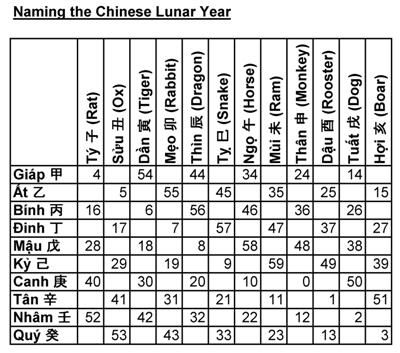The Naming of the Chinese Calendar Year:
Each Chinese lunar year is named based on this system: a combination of one of 10 celestial stems and one of 12 animals.
The 10 celestial stems are:
1) Giáp 甲
2) Ất 乙
3) Bính 丙
4) Đinh 丁
5) Mậu 戊
6) Kỷ 己
7) Canh 庚
8) Tân 辛
9) Nhâm 壬
10) Quý 癸
The 12 animals are:
1) Tý 子 (Rat)
2) Sửu 丑 (Ox)
3) Dần 寅 (Tiger)
4) Mẹo 卯 (Rabbit, Vietnam: Cat)
5) Thìn 辰 (Dragon)
6) Tỵ 巳 (Snake)
7) Ngọ 午 (Horse)
8) Mùi 未 (Ram)
9) Thân 申 (Monkey)
10) Dậu 酉 (Rooster)
11) Tuất 戌 (Dog)
12) Hợi 亥 (Boar)
Thus, when combined together, the names go: Giáp Tý, Ất Sửu, Bính Dần, etc. Since there are 10 stems and 12 animals, there are a total of 60 combinations of possible names. Therefore, in the Chinese way of naming the calendar years, the names repeat every 60 years. This can be confusing, for example: "John was born on the year Nhâm Tuất" which could mean 1862 or 1922 or 1982.
The Conversion from Gregorian Year to Chinese Calendar Year Name:
To convert from Gregorian year to Chinese calendar name, use the following table and the following calculation:

* First, find [Year mod 60], which means finding the remainder of the division of Year and 60. For example, 2010 / 60 = 33, remainder = 30.
* Look up the remainder in the table. That yields the name of the year. For example, looking up 30 in the table, year 2010 is Canh Dần, the year of the Tiger.

No comments:
Post a Comment